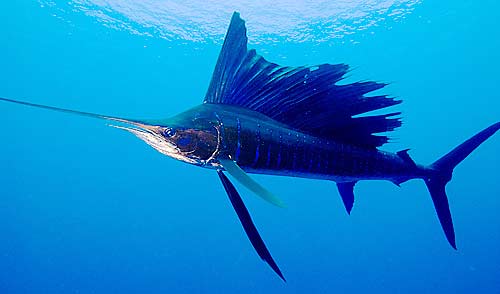Sailfish – The Fastest Swimming Animal

It is very difficult to measure how fast a particular fish can swim, we can only rely on rough estimates. However, the sailfish is undoubtedly fast. It’s predatory behavior and its body structure demonstrate its capacity for speed. Like the nose of a jet its rapier-like bill has been shown to cause what’s called low resistance flow, or in other words, good fluid or hydro-dynamics. It has been recorded as reeling out 300 ft (91 m) of a fisherman’s line in three seconds. That would be faster than a sprinting cheetah, although this speed would include its leaps out of water which shouldn’t really count as swimming speed. Some estimate 60 mph (96 kph) or faster. It also has a strong backbone and a sturdy crescent-shaped tail to complete the sprinting swimmer’s body.
Close behind the sailfish in the top speed racers of fish are other open-water hunters. Those would be the swordfish, marlin, wahoo, yellowfin tuna and bluefin tuna. One of the secrets of the sailfish’s speed, along with that of these other fast predators, lies in its musculature. It has huge amounts of white muscle, great for acceleration but not stamina. This is then boosted along the flanks by blocks of red muscle which need more oxygen but are good for sustained fast swimming. Most of the heat produced by the red muscle fibers is retained by special network of blood vessels making the blood warmer than the surrounding water. It can also channel warm blood to the brain helping it hunt by allowing it to spot and chase prey in colder water and at deeper depths.
The exact function of the huge dorsal fin, or the “sail” remains to be discovered. Some of the more likely uses are that it may assist its fast turning maneuvers, increase the fish’s profile when it’s rounding up prey, act as an actual sail when the fish is at the surface and/or help warm the blood when it is exposed to the sun.

